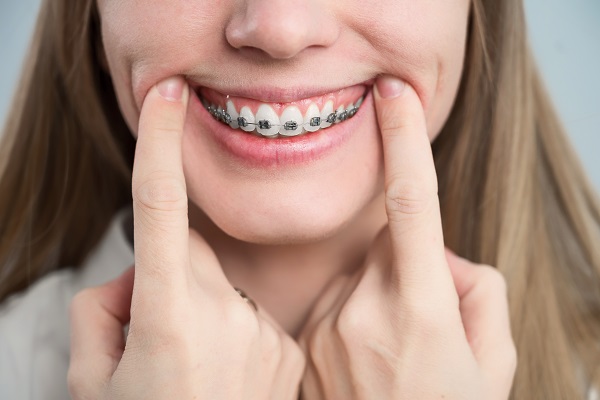Traditional Braces: A Time-Tested Method for Achieving a Perfect Smile

Traditional braces are a proven teeth straightening method that provides a reliable solution. Dentists have long recommended this treatment for all ages to correct misalignments, close gaps, and achieve an even smile. Although there are now several alternatives to traditional braces, they remain one of the most effective and accessible options in general dentistry.
How traditional braces work
Traditional braces consist of small metal or ceramic brackets attached to each tooth and connected by an archwire. The dentist will periodically adjust the tension on this wire throughout the treatment process, guiding the patient's teeth into proper alignment. This process ensures steady and controlled movement, addressing a range of dental issues, including:
- Crooked teeth
- Crowded teeth
- Gapped teeth
- Malocclusions (misalignments)
Traditional braces require regular visits to the general dentist for adjustments, ensuring the patient's progress is closely monitored and their teeth move according to the treatment plan.
Benefits of traditional braces
Durability
Traditional metal braces are known for their long-term durability. They contain high-quality stainless steel or ceramic that withstands daily wear and tear. However, while ceramic brackets offer a more discreet treatment option, metal brackets remain a popular option for their strength and affordability.
Complex cases
Unlike removable clear aligners, traditional braces can tackle complex cases, including severe crowding, overbites, underbites, and crossbites. Their design ensures continuous pressure is exerted by the brackets and archwire system. This is particularly beneficial for individuals who require substantial movement in their dental alignment to improve the appearance and health of their smile.
An option for patients of all ages
Traditional braces are an effective option for patients of all ages. While many teenagers and children wear braces, adults can also undergo teeth straightening treatment. According to the Cleveland Clinic, about 20% of all teeth straightening patients in the United States are over 18.
Additionally, traditional braces are fixed, so they do not rely on patient compliance to be effective. This allows younger patients to continue their daily activities without the added responsibility of managing removable aligners, making it easier to maintain progress toward a straighter smile.
Traditional braces vs. modern alternatives
While there are many modern alternatives to traditional braces, such as clear aligners and lingual braces, traditional braces continue to be a preferred option for certain cases. For example, clear aligners are popular for their discreet appearance. However, they may be less effective for individuals with complex malocclusions. Lingual braces on the back of the teeth offer a discreet option but can be less comfortable and more expensive.
In contrast, traditional braces are accessible and often more cost-effective for long-term treatment. They are covered by many dental insurance plans, making them an affordable choice compared to other teeth straightening options. Dentists often recommend traditional braces for patients who require better precision and control over tooth movement.
Care and maintenance of traditional braces
Patients with traditional braces must follow a consistent oral hygiene routine to prevent plaque buildup around the brackets and wires. A general dentist can provide specific cleaning instructions, including special floss threaders and toothbrushes. Regular checkups ensure the patient's teeth remain healthy throughout treatment.
In addition, traditional braces come with some dietary restrictions, such as hard, crunchy, and sticky foods. These foods can damage the wires and bracks. Instead, stick to soft and easy-to-consume items, such as:
- Oatmeal
- Soups
- Pasta
- Soft breads
- Soft meats
- Soft fruits
- Cooked vegetables
Additionally, after initial braces treatment, patients will need to wear a retainer. This appliance prevents the teeth from shifting back into their old positions.
Call us to learn more
Traditional braces are a time-tested and effective solution for achieving your dream smile. Are you ready to get started? Call our office to learn more or to schedule an appointment.
Request an appointment here: https://totalcaredentalchicago.com or call Total Care Dental at (773) 786-9586 for an appointment in our Chicago office.
Check out what others are saying about our dental services on Yelp: Orthodontics in Chicago, IL.
Related Posts
All-on-X implants offer a stable and natural-looking solution for individuals with multiple missing teeth. For those considering or already living with All-on-X implants, proper care is essential to protect the investment and maintain long-term oral health. With the right routine and professional support, All-on-X implants can deliver years of confident smiles and comfortable function.Cleaning All-on-X…
Choosing a kid-friendly dentist can make for a positive and comfortable start to a child’s oral health journey. A welcoming environment, experienced team, and tailored approach help make early dental visits feel relaxed and reassuring. The goal is to build trust so that children feel comfortable and even excited about oral health, which can lead…
For many people who feel nervous about dental care, laser dentistry offers a calmer, gentler path to treatment. The technology utilizes focused light to treat teeth and gums with reduced noise and vibration compared to traditional tools. This quieter experience helps reduce tension in the chair and can lower the need for numbing in select…
Wisdom teeth removal is considered a type of oral surgery. However, unlike with more invasive surgeries, most patients are able to return home the same day and resume normal activities within the week. Understanding the procedure and aftercare helps patients know what to expect for an extraction.Wisdom teeth are the third set of molars and…

